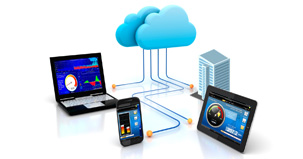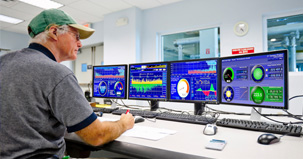- Home
- Smart Data
Smart Data
Actionable intelligence on energy and water use:
- Helps users identify inefficencies, and waste
- Provides real-time feedback on conservation
Right data for the right audience:
- Facility managers identify when and where energy is wasted
- CFO's can track and verify financial savings from initiatives
- Company knows its carbon and water footprint
Related Products
 Information any time, anywhere
Information any time, anywhere - Smart User
Smart User
Smart users leverage real-time data and reduce energy and water use by:
- Continuously identifying opportunities
- Acting on opportunities
- Tracking and verifying savings
- Sustaining savings
Related Products
 Monitor, Manage, Maintain
Monitor, Manage, Maintain - Smart Community
Smart Community
A smart community is one where all stakeholders are engaged in energy and water conservation. A smart community can be achieved by:
- Showing people precisely how much they are using
- Providing real-time feedback on conservation actions
- Effectively communicating efficiency results
Related Products
 Communicate and Conserve
Communicate and Conserve - Smart Grid
Smart Grid
Smart grid, as we define it, is a "green grid", with efficient resource use and the key to a low-carbon future. We help our customers prepare for the smart grid by:
- Engaging users with smart data
- Enabling smart users to increase resource efficiency
- Educating & empowering smart communities
Related Products
 Smart grid and a smarter future
Smart grid and a smarter future - Smart Buildings
Smart Buildings
Smart buildings maximize resource (energy, water, capital) efficiency. These buildings are optimized using energy and water management process with high data visibility which lead to reduced energy and water spending.
- Higher operating income and higher asset values for owners
- Increased productivity for occupants
- Lower carbon footprint for the community
 Resource efficient buildings
Resource efficient buildings
Recent Posts
Business Model Innovation: Bringing Green to Consumers
Cost, logistics, ingrained patterns of behavior and even the clout of established brand names – well, new clean energy business models are overcoming those would-be obstacles to consumer adoption.
The payoff is the greening of consumer lifestyles around the world. This is happening in low-cost, convenient ways that make sense to just about everyone, ranging from sophisticated urbanites in the U.S. to rural dwellers in Brazil.
We know business model innovation (BMI) can jump start progress in industries; that’s nothing new. (Even though we didn’t always have the BMI label for it!) The iconic example is Henry Ford’s mass production system combined with the $5-a-day wage. The commercial car industry became viable and workers could afford the purchase. More recently are these same innovative models are being created and updated by online giants such as Amazon.com.
What is new is that those in clean energy are taking BMI seriously, at last. David Levy, director of the Center for Sustainable Enterprise and Regional Competitiveness at the University of Massachusetts, has written that so much focus had and has been on developing technologies.
In fact, many eyes are always focused on the next best thing.
What but about today? BMI can be leveraged to enable existing technologies to be brought to consumers right now.
So what are some examples of BMI changing the ways consumers consume? Consider the Zipcar. It rebranded the traditional auto leasing industry as “green car-sharing.” And, it did it in a way that even non-greens found the concept unable to resist. The approach includes leasing by the hour, at prices even college students can afford, and widely available rental locations for easy pick-up and return. Last April, Zipcar had an Initial Public Offering and is in 14 cities and on 230 college campuses.
In Brazil, there are areas with no electricity. Fabio Rosa, founder of the Agroelectric System of Appropriate Technology and featured on the PBS “New Heroes” series, introduced distributed solar energy. The BMI for his project, “"The Sun Shines for All,” was to lease instead of selling the photovoltaic solar home system. That made it affordable and less than the cost of non-renewable kerosene and liquid petroleum gas.
A third example enables consumers in nations such as Israel and Denmark to purchase electric cars without the expensive battery. Better Place provides the battery as a service through local service stations. Because this is obviously such a green initiative, governments subsidize the national battery program.
One reason why there hasn’t been more attention paid to BMI until recently had been the same reason for reduction in clean-energy investment: the global economic downturn.
In addition, constituencies be they old-line utilities, software startups, or property owners often drag their feet in the face of regulatory uncertainty or downright confusion. In the latter, U.S. commercial landlords in metro areas such as New York and Washington D.C. have to disclose energy consumption. However, as yet, there is no link between this isolated data and the amount and causes of carbon emissions.
The reality about sustainability is that the global effort is just getting back on-track after the financial meltdown -- leaving more questions than answers. Among the answers, it’s now being recognized, is the potential of BMI. It’s out there as a possible strategy.
One thing which isn’t ambiguous is the demand for measuring impacts on the environment. Noveda Technologies Carbon Footprint Monitor does just that, displaying the real-time impact of any facility on the environment.



